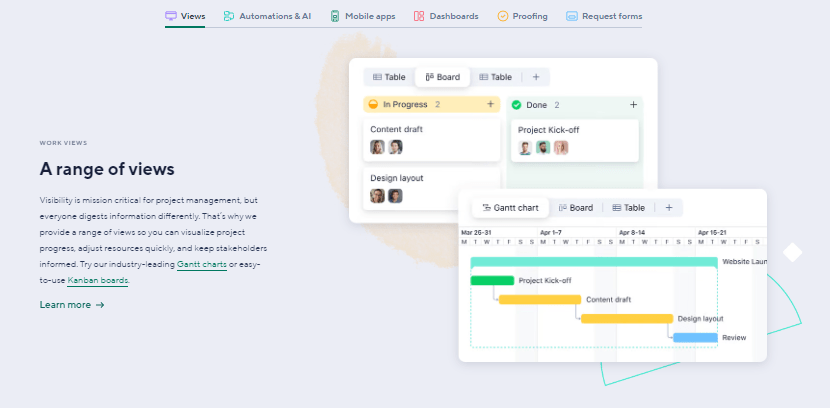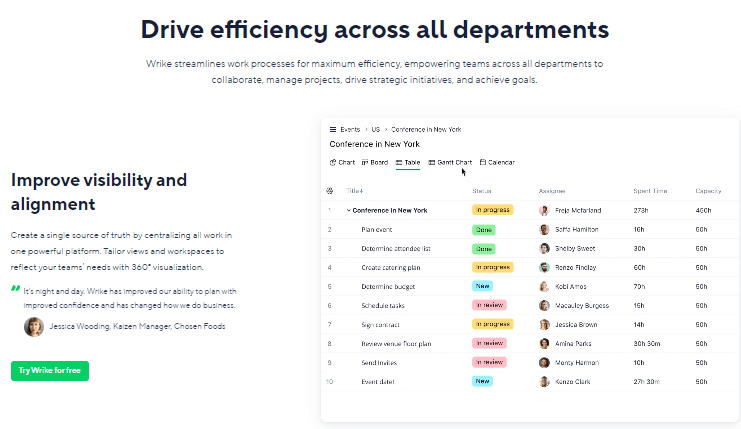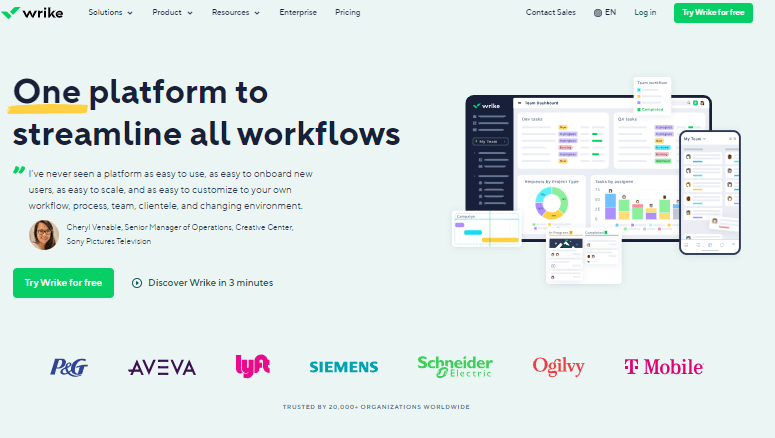Looking to streamline your project management process? Wrike Project Management offers a comprehensive solution that combines simplicity with powerful features. Whether you’re a small team or a large enterprise, Wrike adapts to your needs, providing flexibility and scalability.

Say goodbye to scattered tasks and missed deadlines as Wrike, a work management platform, brings all your projects under one roof, enhancing collaboration and efficiency with gantt charts, time tracking, and integrations. With real-time updates and customizable workflows, Wrike, a project management tool, empowers teams with task management features to work smarter and achieve more. Experience the contrast between chaos and order with Wrike Project Management at your fingertips, featuring gantt, task features, time tracking.
Steps to Integrate Wrike Into Your Project Management Workflow
Integrating Wrike into your project management workflow involves several key steps to ensure effective implementation and utilization. Here’s a structured approach to get started with Wrike:
- Account Setup and Configuration:
- Sign up for a Wrike account on their website.
- Configure your account settings, including team members, project folders, and access permissions.
- Define Project Goals and Structure:
- Clearly define the goals and objectives of your projects.
- Set up project folders, tasks, and subtasks within Wrike to reflect your project’s structure and hierarchy.
- Task and Project Creation:
- Create tasks within Wrike that outline specific actions and deliverables.
- Assign tasks to team members and set deadlines to establish timelines and responsibilities.
- Collaboration and Communication:
- Utilize Wrike’s communication tools, such as comments, @mentions, and task discussions, to facilitate collaboration among team members.
- Ensure all project-related communication and updates are centralized within Wrike for transparency.
- Document Management:
- Upload and organize project-related documents, files, and resources within Wrike.
- Use Wrike’s document editing and version control features to manage document revisions effectively.
- Time Tracking and Reporting:
- Track time spent on tasks using Wrike’s time tracking features or integrations with external time tracking tools.
- Generate reports and analytics within Wrike to monitor project progress, identify bottlenecks, and track team productivity.
- Integration with Other Tools:
- Integrate Wrike with other tools and platforms your team uses, such as CRM systems, email clients, and productivity apps.
- Leverage Wrike’s integrations to streamline data exchange and enhance workflow automation.
- Training and Onboarding:
- Provide training sessions or resources to onboard team members and ensure they understand how to use Wrike effectively.
- Encourage adoption of best practices and Wrike’s features to maximize productivity and collaboration.
- Customization and Optimization:
- Customize Wrike’s workspace, dashboards, and reports to meet your team’s specific needs and preferences.
- Continuously optimize your use of Wrike by incorporating feedback, refining processes, and exploring advanced features.
- Security and Permissions:
- Configure security settings and user permissions within Wrike to protect sensitive project data and ensure data privacy compliance.
- Regularly review and update security measures to maintain a secure project management environment.
By following these steps, you can effectively implement Wrike into your project management workflow, enhancing collaboration, productivity, and project success.
Try Wrike For Free Today!
Sign up for Wrike’s free trial today to experience how it can streamline your project management processes and boost team productivity.
Streamlining Workflows with Wrike
Optimizing Efficiency
Wrike project management offers a comprehensive solution for workflows, enabling teams to streamline processes effectively. By utilizing Wrike’s task management features, teams can assign tasks, set deadlines, and track progress seamlessly. This helps in optimizing workflows by ensuring tasks are completed on time.
Key Points:
- Assign tasks
- Set deadlines
- Track progress
Simplifying Project Management
With Wrike, project management becomes more manageable and efficient. Teams can collaborate in real-time, share files, and communicate effectively within the platform. This simplifies the project management process, reducing the chances of miscommunication and delays.
Key Points:
- Real-time collaboration
- File sharing
- Effective communication
Enhancing Work Processes
By incorporating Wrike into daily operations, organizations can enhance their work processes significantly. The platform provides a centralized location for all project-related information, making it easier for team members to access crucial data quickly. This enhances transparency and accountability within the team.
Key Points:
- Centralized information
- Quick access to data
- Transparency and accountability
Boosting Productivity
One of the top benefits of using Wrike is the boost in productivity it offers. With features designed to streamline workflows and eliminate bottlenecks, teams can work more efficiently and achieve better results in less time. This increased productivity leads to overall business growth and success.
Key Points:
- Workflow optimization
- Elimination of bottlenecks
- Increased efficiency

Enhancing Team Efficiency
Seamless Collaboration
Empower team members to collaborate effectively by utilizing Wrike’s features. With real-time updates and shared task management, teams can work together seamlessly.
Improve communication among teams by utilizing Wrike’s integrated chat function. This feature allows for quick discussions on tasks and projects, enhancing overall collaboration.
Enhance team coordination through Wrike’s shared calendars and timelines. By visualizing project deadlines and milestones, teams can better prioritize tasks and allocate resources efficiently.
Boosting Productivity
Increase efficiency by utilizing Wrike’s automation tools. Automate repetitive tasks to save time and streamline workflows, allowing teams to focus on more complex work.
Enhance work management by using Wrike’s customizable dashboards. Tailor the interface to suit each team member’s preferences, providing a personalized experience that boosts productivity.
Empower user management with Wrike’s role-based permissions. Assign specific roles and access levels to team members, ensuring smooth collaboration while maintaining data security.
Maximizing Performance
Optimize resource allocation through Wrike’s workload view. Visualize each team member’s tasks and capacity, enabling managers to balance workloads effectively.
Improve communication with clients through Wrike’s client portal. Provide transparency into project progress and updates, enhancing customer support and satisfaction.
Enhance enterprise training with Wrike’s learning management system integration. Deliver professional services through customized training modules tailored to each organization’s needs.
Boosting Visibility and Alignment
Centralize Work
Centralizing work on Wrike helps teams align better, ensuring everyone is on the same page. By having all projects, tasks, and updates in one place, team members can easily access and track progress.
When all team members use Wrike as the main platform for project management, it fosters a sense of unity and collaboration. This centralized approach streamlines communication and enhances transparency across different departments.
Customize Workspaces
Customizing workspaces in Wrike allows teams to tailor their views according to their specific needs. By organizing tasks based on relevance and priority, individuals can focus on what matters most, boosting productivity.
With customizable workspaces, each team member can create a personalized dashboard that highlights key projects and deadlines. This customization feature not only improves visibility but also ensures that everyone is working towards the same goals.
Efficient Alignment
Using Wrike as a single source of truth helps departments align their strategies and goals efficiently. By storing all project-related information in one location, teams can avoid confusion and discrepancies that may arise from using multiple platforms.
When departments align their workflows through Wrike, it creates a cohesive environment where everyone is working towards a common objective. This alignment enhances cross-functional collaboration and enables teams to achieve their targets effectively.

Cutting Down on Wasted Efforts
Automate Workflows
Automate workflows in Wrike to streamline processes and eliminate redundant tasks. By setting up automated actions, you can ensure that ongoing work moves smoothly through different stages without manual intervention. This not only saves time but also reduces the risk of errors in task completion.
Time Efficiency
Reduce time spent on administrative duties by leveraging Wrike’s tools and features. With the ability to automate repetitive tasks such as storage space management and file organization, teams can focus more on productive work rather than mundane activities. This helps in keeping all project-related information in a single source, enhancing efficiency and collaboration.
Minimize Duplicate Work
Wrike’s automation features help minimize duplicate work and maximize productivity. By using triggers and actions to automatically assign tasks, notify team members about updates, or move tasks to the next stage upon completion, you can ensure that everyone is on the same page. This prevents unnecessary backtracking and rework, enabling teams to clear requests faster and deliver projects on time.
Accelerating Outcome Delivery
Align Strategy
By utilizing Wrike for project management, teams can better align their custom processes with execution, ensuring a seamless workflow. The platform allows for the creation of tailored workflows that fit the specific needs of each project.
With Wrike, managers can assign tasks, set deadlines, and monitor progress in real-time, ensuring that every team member is on track. This level of visibility helps in aligning strategy with execution, leading to more efficient outcomes.
Drive Results
One of the key benefits of using Wrike is the ability to access real-time insights into project progress and performance. These insights enable teams to make data-driven decisions quickly and adjust strategies as needed to drive better business results.
By leveraging the data and analytics provided by Wrike, teams can identify bottlenecks, allocate resources effectively, and optimize processes for maximum efficiency. This proactive approach to project management accelerates outcome delivery significantly.
Enhance Collaboration
Wrike fosters collaboration among team members by providing a centralized platform where all project-related information is stored. This transparency ensures that everyone is on the same page, leading to smoother communication and faster decision-making processes.
Through features like task assignments, comments, and file sharing, teams can collaborate seamlessly regardless of their location. This enhanced collaboration not only speeds up project delivery but also improves overall team productivity.
Leveraging Versatile Platform Features
Work Views
Utilize Wrike’s various work views to track project progress effectively. The platform offers a table view that displays tasks in a spreadsheet-like format, allowing for quick scanning and editing. The board view provides a visual representation of tasks moving through stages, enhancing team collaboration and workflow management.
Mobile Apps
Access Wrike’s mobile apps to manage projects seamlessly on the go. With the mobile app, users can stay updated on task assignments, deadlines, and project updates in real-time. This feature ensures that team members can collaborate efficiently regardless of their location or time zone.
Templates
Leverage Wrike’s templates to kickstart projects efficiently. The platform offers a variety of pre-built templates for different project types, saving time on setting up new projects from scratch. Users can customize these templates to suit their specific project requirements, ensuring consistency and standardization across projects.
Integrating Seamless Automations
Streamlining Workflows
Automations in Wrike enable users to transform repetitive tasks into automated processes, saving time and increasing productivity. By setting up triggers and actions, integrations can streamline workflows effortlessly. For example, project approvals and requests can be automated, reducing manual intervention and accelerating project timelines.
Boosting Efficiency
By leveraging automation features in Wrike, teams can enhance workflow efficiency significantly. Tasks that require repetitive actions or follow a specific sequence can be automated, allowing team members to focus on more critical aspects of the project. This not only saves time but also ensures consistency in task execution.
Improving Collaboration
Wrike’s automation engine fosters better collaboration among team members by automating notifications, reminders, and updates. Team members are kept informed about project progress, upcoming deadlines, and any changes in task assignments through automated alerts. This real-time communication enhances transparency and ensures everyone is on the same page.
Enhancing Task Management
With automations integrated into Wrike, task management becomes more streamlined and organized. Tasks can be automatically assigned based on predefined criteria, ensuring that the right team members are working on the right tasks at the right time. This reduces confusion, minimizes delays, and improves overall task management efficiency.
Customizing Workflows
Wrike’s automation capabilities allow users to customize workflows according to their specific requirements. By creating custom rules and triggers, teams can tailor integrations to suit their unique project needs. This flexibility empowers teams to design workflows that align with their processes and preferences, leading to more efficient project management.
Utilizing Real-Time Insights
Real-Time Dashboards
Wrike offers real-time dashboards to help project managers make data-led decisions efficiently. These dashboards provide a visual representation of key project metrics, allowing users to track progress and performance accurately. By accessing these dashboards, teams can monitor tasks, deadlines, and overall project health in one centralized location.
Instant Analytics Access
With Wrike, users can gain instant insights into project progress through the platform’s robust analytics capabilities. By leveraging these analytics tools, project managers can track various metrics such as task completion rates, team productivity, and resource allocation. This real-time access to critical data enables teams to identify bottlenecks, address issues promptly, and optimize workflows for better outcomes.
Quick Decision-Making
Jump-Starting Projects Efficiently
Customizable Templates
Kickstart projects and campaigns swiftly by leveraging Wrike’s customizable templates. These templates provide a solid foundation for various project types, streamlining the initial setup process. With pre-built structures in place, project managers can efficiently begin work without starting from scratch.
Request Forms
Save time and energy with Wrike’s request forms designed for seamless project generation. These forms enable team members to submit project requests quickly, capturing essential details upfront. By automating the project initiation process, organizations can ensure a swift transition from idea to execution.
Efficient Project Initiation
Utilize Wrike’s features to efficiently initiate new projects and workflows. By utilizing tools such as Gantt charts, project managers can visually map out project timelines, dependencies, and milestones. This visual representation aids in planning and tracking project progress effectively.
Streamlined Collaboration
Enhance collaboration among team members by utilizing Wrike’s project view. This feature provides a centralized location for all project-related information, including tasks, subtasks, deadlines, and progress updates. Team members can easily access this information, fostering better communication and alignment.
Time Tracking and Budget Management
Improve project efficiency by utilizing Wrike’s time tracking capabilities. Project managers can monitor the time spent on tasks, ensuring optimal resource allocation and timely delivery. budget management tools help organizations stay within financial constraints while executing projects successfully.
Proofing Tools and Subtask Management
Ensure project quality by leveraging Wrike’s proofing tools for efficient feedback collection and approval processes. These tools streamline the review cycle, reducing errors and enhancing overall quality. Furthermore, effective subtask management allows for breaking down complex tasks into smaller, manageable components for improved task execution.
We Recommend 🏆
Sign up for Wrike’s free trial today to experience how it can streamline your project management processes and boost team productivity.

